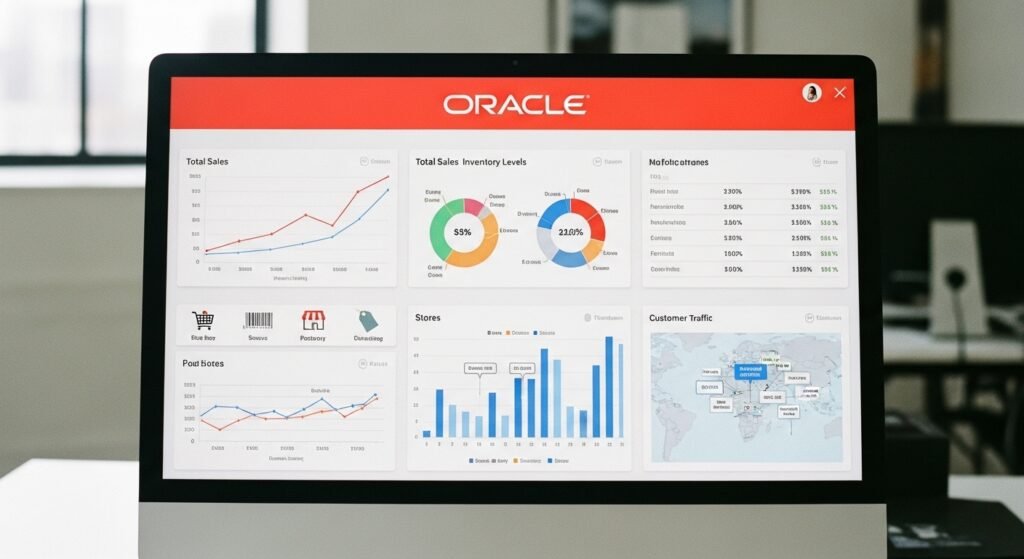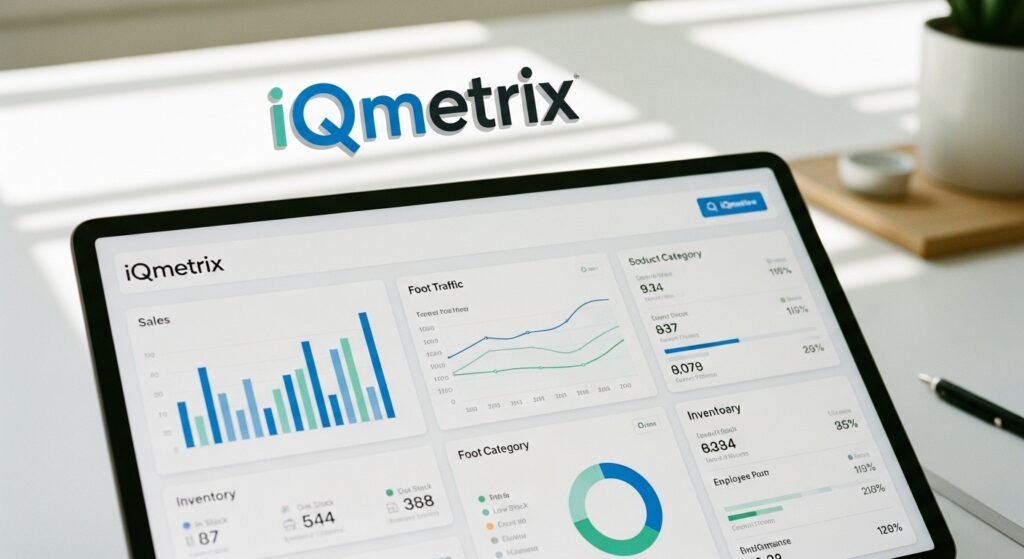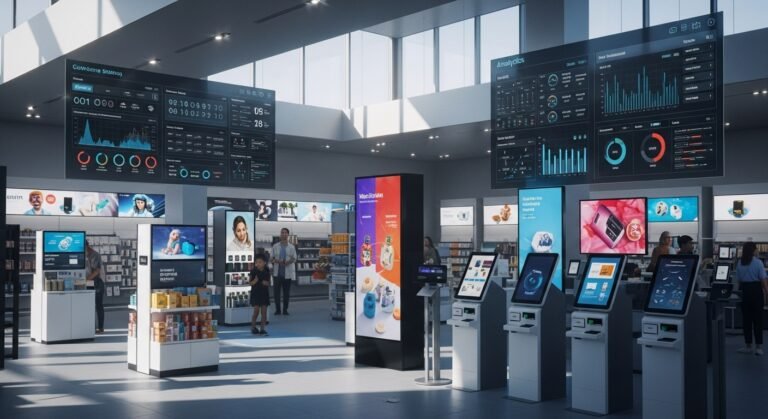Imagine how retail will appear in 2025, as a game of adrenaline where you juggle a complicated system of inventory, customer demands, and a thousand other variables to keep the cash flowing. Start with a small shop and grow to a large chain. A retail management system is the final battle weapon in the automation fight, to sell more and get customers addicted.
These systems have evolved from being mere cash registers to multifunctional hubs featuring merchandising software, store inventory management systems, and assortment planning software for competitive advantage. This time, I want to take you on a tour of the top 10 retail management systems to consider in 2025, their distinguishing features, their main features, their best users, and what can be seen as their negative aspects. Let’s begin!
What Makes a Great Retail Management System in 2025?
A retail management system definition tells us that it is an all-inclusive computer program that is used to automate and simplify retail operations. It helps manage everything from sales transactions, inventory movement, customer relationships, analytics, and more.
What you must look for
The following are the major features that will distinguish a basic system and a best-in-class system in 2025:
- Omnichannel integration: You offer your clients the option to buy your products online on your e-commerce platform, in your physical shop, and even on your social media accounts. A world-class payment solution integrates all of these channels, so your store’s inventory management system is always updated, no matter what.
- Advanced inventory & assortment planning: Interested in what items are in your stores and what isn’t moving off the shelf? With robust retail analytics, you will always have the information needed to make your merchandising management systems more effective.
- Easy usability: No one has the luxury of time that is needed for a complicated interface. A good system uses technologies that are easy to use. This ensures that your team focuses on the clients, not the tech headaches.
- Scalability: From a single small store to a chain of stores, the system, with a small store footprint and large retail areas with complex multi-dimensional assortment planning tools, can scale effortlessly in parallel with the business.
- AI & data-driven features: AI is a critical component in 2025. Make sure to check if they have retail assortment optimization powered by recommendation systems, AI, and inventory streamlining through analytics and predictive forecasting.
If your retail management system lacks these elements, you won’t be able to keep pace. RMS are not simply aids; they are essential to your business since they enable you to optimize customer loyalty programs, stock levels, and profitability.
Next, let’s go straight to the top 10 systems that fulfill these demands.
What Is The Best Retail Management System of 2025
These are the suggested retail stock management systems of 2025. The options to exploit are numerous for everyone, whether it is complex merchandising software, all store inventory management systems, or state-of-the-art assortment planning systems. These systems are considered in terms of functionality, user feedback, and their capabilities to address the contemporary retail requirements.
1. Shopify
Influencing factors that make it unique: Shopify is still a staple in the retail business, as it is a solution for a number of businesses. It is a cloud-based structure, which assists in omnichannel retailing because it helps to bridge the physical stores and online stores.

Key features:
- Controlled inventory in-store and online.
- Automated sale counting, simplified transactions through merchandise and inventory management.
- Integrations with sales tracking and email marketing (e.g., through Mailchimp).
- Promotion planning software assists in planning promotions.
Best use in: Small or medium-sized enterprises that need one integrated solution that provides strong support to e-commerce functionalities.
Pros: Intuitive interface, a wide selection of apps, changing Shopify inventory location to 3rd party, and strong customer support.
Cons: Can become expensive with monthly apps; higher-tier plans are needed for more advanced features like retail assortment optimization.
Why you might pick it: Shopify is known to be easy to use and to scale. The ease and simplicity of the system are valued by retailers who are seeking a strong merchandising management system that is easy to use and that is a plug-and-play system.
2. Oracle Retail
Why it stands out: Oracle Retail is the titan of retailers at the enterprise level. Its AI-based retail planning solutions are a pocket full of analysts.

Key features:
- Assortment planning software.
- Demand forecasting.
- Omnichannel integration.
- Advanced analytics for retail assortment optimization.
- Well-developed store inventory management systems.
Best for: Large retailers that have intricate operations and have numerous retail stores.
Pros: Scalable, all-inclusive, wide range of merchandising solutions and AI technologies.
Cons: Costly; very steep learning curve, and it might be difficult for small enterprises to do so.
The reason you would choose it: Oracle is an advanced, data-centric solution that will be of use to retailers. The AI usage and machine learning software, as well as the reputation of the Oracle company as a leader in the domain of merchandise planning software, contribute to making it a leader in the industry.
3. Increff
Why it is special: Increff is establishing itself in the retail tech sector with SaaS systems that are solving the real-life problems of supply chain management and inventory management.
Key features:
- Auto-replenishment.
- Smart assortment planning.
- Demand-driven allocation.
- Real-time data dashboards (Business Intelligence).
- Omnichannel inventory visibility.
- Intelligent markdown automation; visibility into actionable sales strategies.
Best for: Mid-sized to large-scale retailers, e-commerce, cosmetics, or fashion/electronics brands.
Pros: State-of-the-art AI analytics and omnichannel integration of operations, which can be scaled internationally. Good inventory optimization planning.
Cons: Advanced features can be daunting to very simple and small retailers. Users have been complaining of the high learning curve of retail merchandising software suites.
Why you can choose it: Increff offers a mix of omnichannel and AI-based merchandising management systems that will benefit retailers seeking to maximize their operations and discover the untapped profits.
4. Lightspeed Retail
The reason why it is distinctive: Lightspeed Retail is an integrated, cloud-based point of sale system that easily incorporates e-commerce into retail outlets and has a robust combination of retail merchandising solutions and store inventory management systems.

Key features:
- Retail analytics.
- Store inventory.
- E-commerce integration.
- Secure POS system.
- Comprehensive assortment planning software to optimize displays.
Best For: Fashion, electronics, or mid-sized stores that want to expand.
Pros: The interface is modern, easy to use, well supported by omnichannel, and has 24/7 customer support.
Cons: There are occasional glitches that have been reported by users; when several features are added, the pricing can be very high.
Why you would choose it: Lightspeed is easy to use yet offers powerful features that make it an excellent option for businesses that are looking to grow without necessarily transitioning to an enterprise level.
5. Aptos Retail
Why it stands out: Aptos Retail is a beast in the scope of comprehensive retail management. Tailored to mid to large retailers, it features top-of-the-line merchandising software that syncs with warehousing and accounting modules.
Key features:
- Real-time inventory updates.
- Advanced analytics.
- Omnichannel order processing.
- Powerful merchandising solutions and assortment planning tools.
Best for: Fashion, grocery, and electronics retailers of medium to large scale.
Pros: Customizable, scalable, full feature set.
Cons: Pricing has no free tier; complex initial setup.
Why you may consider it: Aptos has a holistic retail planning solution, with its intensive analytics, that provides sophisticated retail planning to any retailer who requires more advanced retail planning systems.
Net Income Zone will assist you with smart money ideas, passive income strategies, and business insights to diversify your wealth effortlessly. Start building financial freedom today!
6. iQmetrix
Why it stands out: iQmetrix has been touted to have good retail POS systems, which provide wholesome retail management with inventory, payments, and customer interaction capabilities.

Key features:
- Inventory management.
- Payment processing.
- CRM (customer relationship management).
- Analytics tailored for optimizing retail assortments.
- Planogram development tools for visual merchandising.
Best for: Specialty retail, such as electronics or telecom stores.
Pros: Strong integration with digital touchpoints; favorable user experience.
Cons: Limited focus; may not be as versatile for wide-ranging retail operations beyond its specialty sectors.
Why you might pick it: If you are in a tech-focused retail vertical and you need a system that emphasizes customer experience and omnichannel sales, iQmetrix is a strong candidate.
7. Retail Pro
Why it stands out: Retail Pro is not a new company and has established a good reputation in the specialty retail platform. Merchandise planning software with a customized workflow. It is highly customizable with strong tools for merchandising and inventory management.
Key features:
- POS.
- Inventory management.
- Customer management.
- Over 150 pre-loaded reports.
- Merchandise planning software with a customized workflow.
Best For: Specialty retailers such as apparel stores, jewelry stores, and boutiques.
Pros: High level of customization, powerful analytical functionality, and a host of reporting capabilities.
Cons: Complicated configuration; not all of them are transparently priced.
Why you would choose it: Retailers who need flexibility in their merchandising management systems, and flexibility in/configuration of workflows, will like the richness of Retail Pro.
8. Zoho Inventory
Why it stands out: Part of the Zoho ecosystem, Zoho Inventory provides a retail management solution tailored to users of other Zoho tools. It not only does well in warehouse management but also in merchandising of retailing.

Key features:
- Inventory tracking.
- Order management.
- Point-of-sale systems.
- Customer relationship management systems.
- Analytics and business intelligence.
- The assortment planning tools make sure that there is a balanced stock in all channels.
Best suited: Small to mid-sized enterprises that are multi-channel and already use Zoho applications.
Pros: Low cost, can be integrated instantly with the rest of the Zoho applications.
Cons: Enterprise-level retailers have few advanced features.
Why you could choose it: Zoho Inventory is a good value option because it is a well-integrated solution that offers small-to mid-sized retailers the ability to find a low-cost solution.
9. Quant Retail
Why it is special: Quant Retail is your solution to store planning and category management. Its cloud-based platform is packed with retail assortment optimization and merchandising software, making planogram creation easier than ever.

Key features:
- Floor-plan editor.
- Planogram optimization.
- Sales data analytics.
- Task management.
- Uses AI for precision in their assortment planning tools.
Best for: Retailers that specialize in visual merchandising and spatial optimization — e.g., fashion, specialty stores, chains with many SKUs.
Pros: User-friendly, great for planograms, scalable.
Cons: Wider retail management requirements (e.g., full POS, full CRM) are limited to full-stack systems.
Why you might pick it: If you’re especially focused on store layout, category management, and visual merchandising efficiency, Quant Retail is well-suited.
10. AssortSmart
Why it stands out: AssortSmart is a relatively new company, and it is based on AI technology in assortment planning. In the context of merchandise planning software, the platform is AI-native and is characterized by a focus on precision.

Key features:
- Forecasting demand using AI.
- Assortment planning on a micro level.
- SKU optimization.
- Sophisticated analytics leading to the best profitability.
Best For: Retailers interested in applying AI technology in the retail assortment optimization and keeping up with the trend.
Pros: State-of-the-art AI technology will reduce markdowns and raise inventory turns.
Cons: Smaller retailers with basic needs may find it too specialized and possibly costly.
Why you might pick it: For data-driven retailers in 2025 who want to squeeze every drop of efficiency from their stock and assortment, the AI-powered approach makes AssortSmart a revolutionary solution.
Bottom Line
In a nutshell, the retail management system is a great one that would make more wise decisions, be more profitable, and deliver a smooth experience through all channels. Knowing your business size, budget, and the needs of your operations, you can select the RMS that is really able to support growth and accuracy.
Success in retailing in 2025 is all about smarter management. Now is the day to invest in the perfect retail management system, because tomorrow you will have established your business of sustainable growth, optimized efficiency, and more satisfied customers.
Net Income Zone will help you master generating various sources of income and earn your tomorrow without struggling.
FAQs
1. What is a retail management system definition?
A retail management system (RMS) refers to software that assists store owners in managing sales, inventory, customers, and reports all at a single location. It simplifies the day-to-day activities.
2. What is the most suitable retail management system to use by the small business?
Shopify and Zoho Inventory suit better when the store is small or growing. They are very easy to operate, cheap, and their features are accompanied by tools used to control online and in-store sales.
3. What is the benefit of using a retail stock management system in increasing profits?
RMS can be used to monitor sales, stock, and demonstrate the best-selling products. Having such data, you are able to minimize waste, replenish in a clever manner, and enhance profits, yet have customers satisfied.
Emily Roberts is a chartered accountant and financial advisor who specializes in income tax and small business compliance. She writes to simplify complex tax concepts for everyday readers.

